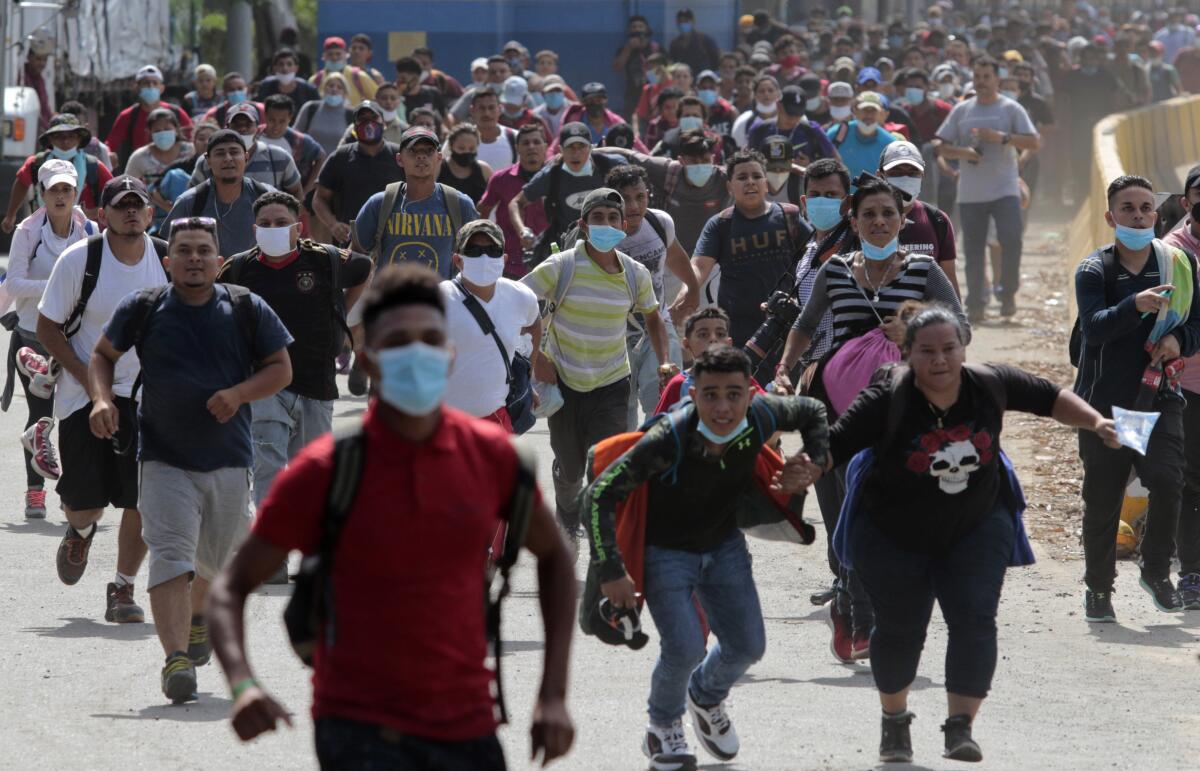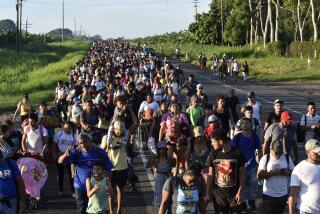Thousands of Honduran migrants set out for U.S. amid pandemic

- Share via
GUALÁN, Guatemala — About 2,000 Honduran migrants hoping to reach the United States entered Guatemala on foot Thursday morning, testing the newly reopened frontier that had been shut by the COVID-19 pandemic.
Authorities had planned to register the migrants as they crossed and offer assistance to those willing to turn back, but the group crossed the official border at Corinto without registering, pushing past outnumbered Guatemalan police and soldiers who made little attempt to stop them.
In one group were four teenagers, all friends and neighbors from San Pedro Sula, from which hundreds of migrants had set out the previous night. The teens decided to leave after seeing others organize on Facebook.
The youngest, 15-year-old Josty Morales, said he wanted to live the “American dream” and was looking for a way to support his 6-month-old son at home. “There’s no work. The necessity strangles you,” he said.
Within hours of the border crossing, Guatemalan authorities reported the first migrant death. A person tried to climb aboard a moving flatbed trailer, but fell under its wheels. Authorities did not immediately provide any additional details.
Central American migrants began traveling in large groups in recent years, seeking safety in numbers and in some cases avoiding the cost of smugglers. Calls for a new migrant caravan to leave Oct. 1 had circulated for weeks on social media.
The odds of a large migrant caravan reaching the U.S. border, already low, have grown increasingly slim over the last year. Under pressure from the United States, Mexico deployed its National Guard and more immigration agents to break up attempted caravans last year. They dispersed large groups of migrants attempting to travel together in southern Mexico. Crossing into the U.S. legally is virtually impossible now amid the pandemic, and entering illegally is as difficult as ever.
The departure of the new group was reminiscent of a migrant caravan that formed two years ago, shortly before U.S. midterm elections. It became a hot issue in the campaign, fueling anti-immigrant rhetoric. While such caravans draw attention, they really account for only a small fraction of the daily migration by small groups that pass unnoticed through Central America and Mexico.
By midafternoon the migrants who crossed into Guatemala on Thursday had spread out in small groups for miles along the highway, as some caught rides and others walked under the hot sun.
Christian Martínez, 19, saw leaving as a way out when few other options were apparent in Honduras. “If we stay what is left for us is to become criminals because there’s no way to survive,” he said.
Already halfway to Guatemala City, Martínez and his companions had advanced on foot and with the occasional ride. They said they all carried masks but weren’t worried about the coronavirus.
The larger group that set out Wednesday night appeared to be mostly young men, though there were the occasional small children being pushed in strollers.
At the border, Guatemalan officials were asking the migrants to provide documents showing a negative COVID-19 test — even though last week they said they wouldn’t require a test for those spending less than 72 hours in the country.
But about 2,000 migrants hustled through without registering. In addition, AP journalists saw others crossing the border illegally near the formal crossing. There were no reports of violence.
Guatemala’s military said it was establishing interior checkpoints to review migrants’ documents. In the past, authorities have set up roadblocks deeper in the country to winnow down larger groups. A regional agreement allows citizens of Honduras to transit through Guatemala.
Governments throughout the region made it known they were watching Wednesday.
Guatemalan presidential spokeswoman Francis Masek said in a statement that authorities would enforce the law.
“We understand that the economic situation of the Northern Triangle countries has become more critical with the effects of the pandemic, but this does not justify taking the risk for adults, much less children, of starting the trip toward the United States, which is so dangerous and includes many situations that can put lives at risk,” the statement said.
Mexico’s immigration agency said in a statement that it would enforce “safe, orderly and legal” migration and not do anything to promote the formation of a caravan. The U.S. Embassy in Honduras said Wednesday on Twitter that migration to the U.S. was more difficult than ever right now — and more dangerous because of the coronavirus.
But the factors driving migrants to leave Central America certainly haven’t eased during the pandemic. As economies have suffered, there are ever fewer jobs to be had, and the struggle for families to put food on the table has only worsened. Some migrants also cited the ever-present high rate of crime.
The United Nations’ International Labor Organization said Wednesday that at least 34 million jobs have been lost in Latin America because of the pandemic. The ILO lists Latin America and the Caribbean as the worst-hit region in the world in terms of lost working hours, with a drop of 20.9% in the first three quarters of the year.
The flow of migrants north from Central America had slowed dramatically during the pandemic as countries throughout the region closed their borders. Most migrant shelters along the principal routes closed their doors to new arrivals as they tried to keep the virus from spreading to vulnerable populations. Mexico and the U.S. deported hundreds of migrants to their home countries to try to empty detention centers.
Guatemala has now opened all of its borders, including the one with Mexico. But the U.S.-Mexico border remains closed for nonessential travel, and the U.S. government in effect shut down the asylum system at its southern border during the pandemic.
Mexico tried to bus asylum seekers stuck at its northern border to other parts of the country and back to their home countries. Mexico has typically offered migrants the opportunity to seek asylum there, but many have their minds set on the United States. Migrants are also likely to find it more difficult to find work in Mexico now as the economy is expected to contract 10% this year because of the pandemic.
More to Read
Sign up for Essential California
The most important California stories and recommendations in your inbox every morning.
You may occasionally receive promotional content from the Los Angeles Times.










